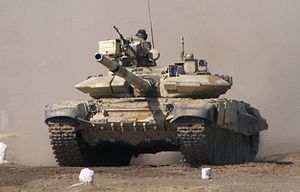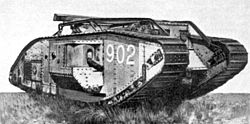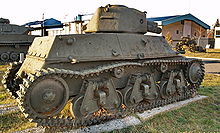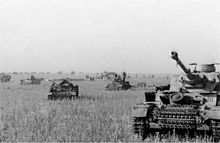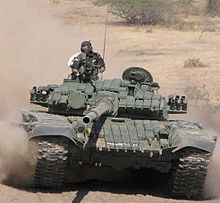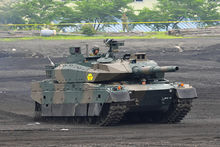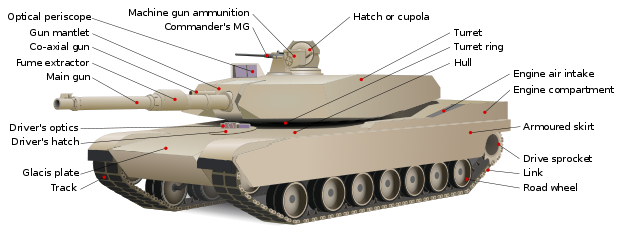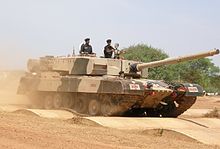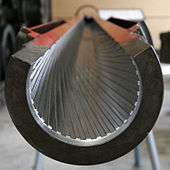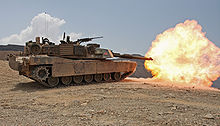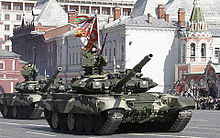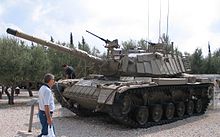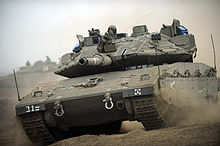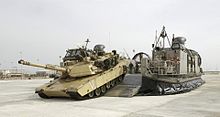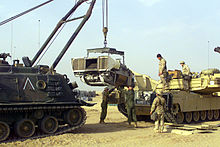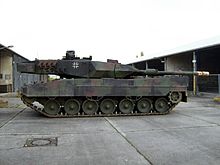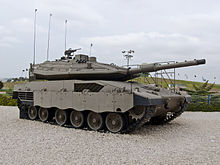
Tank
Did you know...
This Wikipedia selection is available offline from SOS Children for distribution in the developing world. Before you decide about sponsoring a child, why not learn about different sponsorship charities first?
|
||||||||
A tank is a tracked, armoured fighting vehicle designed for front-line combat which combines operational mobility and tactical offensive and defensive capabilities. Firepower is normally provided by a large- calibre main gun in a rotating turret and secondary machine guns, while heavy armour and all-terrain mobility provide protection for the tank and its crew, allowing it to perform all primary tasks of the armoured troops on the battlefield.
Tanks in World War I were developed separately and simultaneously by Great Britain and France as a means to break the deadlock of trench warfare on the Western Front. Their first use in combat was by the British Army on September 15, 1916 at Flers-Courcelette, during the Battle of the Somme. The name "tank" was adopted by the British during the early stages of their development, as a security measure to conceal their purpose (see etymology). While the French and British built thousands of tanks between them, Germany developed and brought into service only a single design the A7V producing 20 vehicles due to lack of capacities or resources.
Tanks of the interwar period evolved into the designs of World War II. Important concepts of armoured warfare were developed; the Soviet Union launched the first mass tank/air attack at Khalkhin Gol ( Nomonhan) in August 1939, which later resulted in the T-34, a predecessor of the main battle tank; this was quickly followed up by Germany on a larger scale when they introduced blitzkrieg ('lightning war') less than two weeks later; a technique which made use of massed concentrations of tanks supported by artillery and air power to break through the enemy front and cause a complete collapse in enemy resistance and morale.
Tanks in the Cold War advanced to counter greater battlefield threats. Tanks became larger and their armour became thicker and much more effective. Advances in manufacturing late in the war allowed the mass production of composite armor. Aspects of gun technology changed significantly as well, with advances in shell design.
During the 20th century, main battle tanks were considered a key component of modern armies. In the 21st century, with the increasing role of asymetrical warfare and the end of the Cold War, that also contributed to the increase of cost-effective Russian anti-tank weapons worldwide, the importance of tanks has waned. Modern tanks seldom operate alone, as they are organized into armoured units which involve the support of infantry, who may accompany the tanks in infantry fighting vehicles. They are also usually supported by reconnaissance or ground-attack aircraft.
History
Conception
The tank is the 20th century realization of an ancient concept: that of providing troops with mobile protection and firepower. The internal combustion engine, armour plate, and the continuous track were key innovations leading to the invention of the modern tank.
Armoured trains appeared in the mid-19th century, and various armoured steam- and petrol-engined vehicles were also proposed. The first armoured car was produced in Austria in 1904. However, all were restricted to rails or reasonably passable terrain. It was the development of a practical caterpillar track that provided the necessary independent, all-terrain mobility.
Many sources imply that Leonardo da Vinci and H.G. Wells in some way foresaw or "invented" the tank. Da Vinci's late 15th century drawings of what some describe as a "tank" show a man-powered, wheeled vehicle with cannons all around it. The machines described in Wells's 1903 short story The Land Ironclads are a step closer, in being armour-plated, having an internal power plant, and being able to cross trenches. Some aspects of the story foresee the tactical use and impact of the tanks that later came into being. However, Wells's vehicles were driven by steam and moved on Pedrail wheels, technologies that were already outdated at the time of writing. After seeing British tanks in 1916, Wells denied having "invented" them, writing, "Yet let me state at once that I was not their prime originator. I took up an idea, manipulated it slightly, and handed it on." It is, though, possible that one of the British tank pioneers, Ernest Swinton, was subconsciously or otherwise influenced by Wells's tale.
The "caterpillar" track arose from attempts to improve the mobility of wheeled vehicles by spreading their weight, reducing ground pressure, and increasing their adhesive friction. Experiments can be traced back as far as the 17th century, and by the late nineteenth they existed in various recognizable and practical forms in several countries.
It is frequently claimed that Richard Lovell Edgeworth created a caterpillar track. It is true that in 1770 he patented a "machine, that should carry and lay down its own road", but this was Edgeworth's choice of words. His own account in his autobiography is of a horse-drawn wooden carriage on eight retractable legs, capable of lifting itself over high walls. The description bears no similarity to a caterpillar track.
The first combinations of the three principal components of the Tank appeared in the decade before World War One. In 1903, a Captain Levavasseur of the French Artillery proposed mounting a field gun in an armoured box on tracks. A Major in the British Army's Mechanical Transport Service suggested fixing a gun and armoured shield on a British type of track-driven vehicle. In 1911, a Lieutenant Engineer in the Austrian Army, Günther Burstyn, presented to the Austrian and Prussian War Ministries plans for a two-man tank with a gun in a revolving turret. In the same year an Australian civil engineer named Lancelot de Mole submitted a basic design for a tracked, armoured vehicle to the British War Office. In Russia, Vasiliy Mendeleev designed a tracked vehicle containing a large naval gun.
All of these ideas were rejected and, by 1914, forgotten, although it was officially acknowledged after the War that de Mole's design was at least the equal of the tanks that were later produced by Great Britain, and he was voted a cash payment for his contribution. Various individuals continued to contemplate the use of tracked vehicles for military applications, but by the outbreak of the War no one in a position of responsibility in any army had any thoughts about tanks.
World War I
Great Britain
From late 1914 a small number of middle-ranking British Army officers tried to persuade the War Office and the Government to consider the creation of armoured vehicles. Amongst their suggestions was the use of caterpillar tractors, but although the Army used many such vehicles for towing heavy guns, it could not be persuaded that they could be adapted as armoured vehicles. The consequence was that early tank development in Great Britain was carried out by the Royal Navy.
As the result of an approach by Royal Naval Air Service officers who had been operating armoured cars on the Western Front, the First Lord of the Admiralty, Winston Churchill. formed the Landships Committee, on 20 February 1915. The Director of Naval Construction for the Royal Navy, Eustace Tennyson d'Eyncourt, was appointed to head the Committee in view of his experience with the engineering methods it was felt might be required; the two other members were naval officers, and a number of industrialists were engaged as consultants. So many played a part in its long and complicated development that it is not possible to name any individual as the sole inventor of the tank, though the British Government later made proportionate cash awards to those it considered to have contributed. Their first design, Little Willie, ran for the first time in September 1915 and served to develop the form of the track but an improved design, better able to cross trenches, swiftly followed and in January 1916 the prototype, nicknamed "Mother", was adopted as the design for future tanks. Production models of "Male" tanks (armed with naval cannon and machine guns) and "Females" (carrying only machine-guns) would go on to fight in history's first tank action at the Somme in September 1916. Great Britain produced about 2,600 tanks of various types during the War.
The first tank to engage in battle was designated D1, a British Mark I Male, during the Battle of Flers-Courcelette (part of the wider Somme offensive) on 15 September 1916.
France
Whilst several experimental machines were investigated in France, it was a colonel of artillery, J.B.E. Estienne, who directly approached the Commander-in-Chief with detailed plans for a tank on caterpillar tracks, in late 1915. The result was two largely unsatisfactory types of tank, 400 each of the Schneider and Saint-Chamond, both based on the Holt Tractor.
The following year, the French pioneered the use of a full 360° rotation turret in a tank for the first time, with the creation of the Renault FT light tank, with the turret containing the tank's main armament. Aside of the traversable turret another innovative feature of the FT was its engine located at the rear. This pattern, with the gun located in a mounted turret and the engine at the back, became the standard for most succeeding tanks across the world even to this day. The FT was the most numerous tank of the War; over 3,000 were made by late 1918.
Germany
In contrast to World War II, Germany fielded very few tanks during World War I, with only 20 of the A7V type being produced during the war. The first tank versus tank action took place on 24 April 1918 at the Second Battle of Villers-Bretonneux, France, when three British Mark IVs met three German A7Vs. Captured British Mk IVs formed the bulk of Germany's tank forces during WWI; about 35 were in service at any one time. Plans to expanded the tank programme were under way when the War ended.
Other Nations
The United States used tanks supplied by France and Great Britain during WWI. Production of American-built tanks had just begun when the War came to an end. Italy also manufactured two Fiat 2000s towards the end of the War, too late to see service. Russia independently built and trialled two prototypes early in the War; the tracked, two-man Vezdekhod and the huge Lebedenko, but neither went into production. A tracked self-propelled gun was also designed but not produced.
Although tank tactics developed rapidly during the war, piecemeal deployments, mechanical problems, and poor mobility limited the military significance of the tank in World War I, and the tank did not fulfil its promise of rendering trench warfare obsolete. Nonetheless, it was clear to military thinkers on both sides that tanks would play a significant role in future conflicts.
Interwar period
In the interwar period tanks underwent further mechanical development. In terms of tactics, J.F.C. Fuller's doctrine of spearhead attacks with massed tank formations was the basis for work by Heinz Guderian in Germany, Percy Hobart in Britain, Adna R. Chaffee, Jr., in the U.S., Charles de Gaulle in France, and Mikhail Tukhachevsky in the USSR. All came to similar conclusions, but in the Second World War only Germany would initially put the theory into practice on a large scale, and it was their superior tactics and French blunders, not superior weapons, that made blitzkrieg so successful in May 1940. For information regarding tank development in this period, see tank development between the wars.
Germany, Italy and the Soviet Union all experimented heavily with tank warfare during their clandestine and “volunteer” involvement in the Spanish Civil War, which saw some of the earliest examples of successful mechanised combined arms — such as when Republican troops, equipped with Soviet-supplied medium tanks and supported by aircraft, eventually routed Italian troops fighting for the Nationalists in the seven-day Battle of Guadalajara in 1937. However, of the nearly 700 tanks deployed during this conflict, only about 64 tanks representing the Franco faction and 331 from the Republican side were equipped with cannon, and of those 64 nearly all were WWI vintage Renault FT tanks, while the 331 Soviet supplied machines had 45mm main guns and were of 1930s manufacture. With the balance of Nationalist tanks being machine gun armed tanks. The primary lesson learned from this war was that machine gun armed tanks had to be equipped with cannon, with the associated armor inherent to modern tanks.
The five month long war between the Soviet Union and the Japanese 6th Army at Khalkhin Gol ( Nomonhan) in 1939 brought home some better lessons. In this conflict, and although the Japanese only deployed about 73 cannon armed tanks, the Soviets fielded over two thousand, with the major difference being that Japanese armor were equipped with diesel engines and the Russian tanks petrol ones. Even after General Georgy Zhukov sounded a bitter defeat on the Japanese 6th Army with his massed combined tank and air attack, the Soviets had learned a bitter lesson on the use of gasoline engines, and quickly incorporated those newly found experiences into their new T-34 medium tank during WWII.
World War II
World War II was the first conflict where armoured vehicles were critical to success on the battlefield and in this period the tank developed rapidly as a weapon system. It showed how an armoured force was capable of achieving a tactical victory in an unprecedentedly short amount of time. At the same time, however, the development of effective anti-tank weaponry demonstrated that the tank was not invulnerable.
Prior to World War II the tactics and strategy of deploying tank forces underwent a revolution. In August 1939 Soviet General Georgy Zhukov utilized the combined force of tanks and airpower at Nomonhan against the Japanese 6th Army; Heinz Guderian, a tactical theoretician who was heavily involved in the formation of the first independent German tank force, said "Where tanks are, the front is", and this concept became a reality in World War II. Following the Invasion of Poland where tanks performed in a more traditional role in close cooperation with infantry units, in the Battle of France deep independent armoured penetrations were executed by the Germans, a technique later called blitzkrieg. Blitzkrieg made use of innovative combined arms tactics and radios in all of the tanks to provide a level of tactical flexibility and power that surpassed that of the Allied armour. The French Army, with tanks equal or superior to the German tanks in both quality and quantity, employed a linear defensive strategy in which the armoured cavalry units were made subservient to infantry as "support weapons". In addition, they lacked radios in many of their tanks and headquarters, which limited their ability to respond to German attacks.
In accordance with blitzkrieg methods, German tanks bypassed enemy strongpoints and could radio for close air support to destroy them, or leave them to the infantry. A related development, motorized infantry, allowed some of the troops to keep up with the tanks and create highly mobile combined arms forces. The defeat of a major military power within weeks shocked the rest of the world, resulting in an increased focus on tank and anti-tank weapon development.
The North African Campaign also provided an important battleground for tanks, as the flat, desolate terrain with relatively few obstacles or urban environments was ideal for conducting mobile armoured warfare. However, this battlefield also showed the importance of logistics, especially in an armoured force, as the principal warring armies, the German Afrika Korps and the British Eighth Army, often outpaced their supply trains in repeated attacks and counter-attacks on each other, resulting in complete stalemate. This situation would not be resolved until 1942, when during the Second Battle of El Alamein, the Afrika Korps, crippled by disruptions in their supply lines, had 95% of its tanks destroyed and was forced to retreat by a massively reinforced Eighth Army, the first in a series of defeats that would eventually lead to the surrender of the remaining Axis forces in Tunisia.
The German invasion of the Soviet Union, Operation Barbarossa, started with the Soviets having a superior tank design, the T-34. A lack of preparations for the Axis surprise attack, mechanical problems, poor training of the crews and incompetent leadership caused the Soviet machines to be surrounded and destroyed in large numbers. However, interference from Adolf Hitler, the geographic scale of the conflict, the dogged resistance of the Soviet combat troops, and Soviet manpower and production capability prevented a repeat of the Blitzkrieg of 1940. Despite early successes against the Soviets, the Germans were forced to up-gun their Panzer IVs, and to design and build larger and more expensive Panther and Tiger tanks. In doing so, the Wehrmacht denied the infantry and other support arms the production priorities that they needed to remain equal partners with the increasingly sophisticated tanks, in turn violating the principle of combined arms they had pioneered. Soviet developments following the invasion included upgunning the T-34, development of self-propelled anti-tank guns such as the SU-152, and deployment of the IS-2 in the closing stages of the war.
When entering World War II, America's mass production capacity enabled her to rapidly construct thousands of relatively cheap M4 Sherman medium tanks. A compromise all round, the Sherman was reliable and formed a large part of the Anglo-American ground forces, but in a tank-versus-tank battle was no match for the Panther or Tiger. Numerical and logistical superiority and the successful use of combined arms allowed the Allies to overrun the German forces during the Battle of Normandy. Upgunned versions with the 76 mm gun M1 and the 17 pounder were introduced to improve the M4's firepower, but concerns about protection remained.
Tank hulls were modified to produce flame tanks, mobile rocket artillery, and combat engineering vehicles for tasks including mine-clearing and bridging. Specialised self-propelled guns were also developed: tank destroyers and assault guns were cheap, stripped down tanks carrying heavy guns, often in a fixed hull mounting. The firepower and low cost of these vehicles made them attractive but as manufacturing techniques improved and larger turret rings made larger tank guns feasible, the gun turret was recognised as the most effective mounting for the main gun to allow movement in a different direction from firing, enhancing tactical flexibility.
The Cold War arms race
During the Cold War, tension between the Warsaw Pact countries and North Atlantic Treaty Organisation (NATO) countries created an arms race that ensured that tank development proceeded largely as it had during World War II. The essence of tank designs during the Cold War had been hammered out in the closing stages of World War II. Large turrets, capable suspension systems, greatly improved engines, sloped armour and large-calibre (90 mm and larger) guns were standard. Tank design during the Cold War built on this foundation and included improvements to fire control, gyroscopic gun stabilisation, communications (primarily radio) and crew comfort and saw the introduction of laser rangefinders and infrared night vision equipment. Armour technology progressed in an ongoing race against improvements in anti-tank weapons, especially antitank guided missiles like the TOW.
Medium tanks of World War II, evolved into the main battle tank (MBT) of the Cold War and took over the majority of tank roles on the battlefield. This gradual transition occurred in the 1950s and 1960s due to anti-tank guided missiles, sabot ammunition and high explosive anti-tank warheads. World War II had shown that the speed of a light tank was no substitute for armour and firepower and medium tanks were vulnerable to newer weapon technology, rendering them obsolete.
In a trend started in World War II, economies of scale led to serial production of progressively upgraded models of all major tanks during the Cold War. For the same reason many upgraded post-World War II tanks and their derivatives (for example, the T-55 and T-72) remain in active service around the world, and even an obsolete tank may be the most formidable weapon on battlefields in many parts of the world. Among the tanks of the 1950s were the British Centurion and Soviet T-54/55 in service from 1946, and the US M48 from 1951. These three vehicles formed the bulk of the armoured forces of NATO and the Warsaw Pact throughout much of the Cold War. Lessons learned from tanks such as the Leopard 1, M48 Patton series, Chieftain, and T-72 led to the contemporary Leopard 2, M1 Abrams, Challenger 2, C1 Ariete, T-90 and Merkava IV.
Tanks and anti-tank weapons of the Cold War era saw action in a number of proxy wars like the Korean War, Vietnam War, Indo-Pakistani War of 1971, Soviet war in Afghanistan and Arab-Israeli conflicts, culminating with the Yom Kippur War. The T-55, for example, has seen action in no fewer than 32 conflicts. In these wars the USA or NATO countries and the Soviet Union or China consistently backed opposing forces. Proxy wars were studied by Western and Soviet military analysts and provided a grim contribution to the Cold War tank development process.
21st century conflicts
The role of tank vs. tank combat is becoming diminished. Tanks work in concert with infantry in urban warfare by deploying them ahead of the platoon. When engaging enemy infantry, tanks can provide covering fire on the battlefield. Conversely, tanks can spearhead attacks when infantry are deployed in personnel carriers.
Tanks were used to spearhead the initial US invasion of Iraq in 2003. As of 2005, there were 1,100 M1 Abrams used by the United States Army in the course of the Iraq War, and they have proven to have an unexpectedly high level of vulnerability to roadside bombs. A relatively new type of remotely detonated mine, the explosively formed penetrator has been used with some success against American armoured vehicles (particularly the Bradley fighting vehicle). However, with upgrades to their armour in the rear, M1s have proven invaluable in fighting insurgents in urban combat, particularly at the Battle of Fallujah, where the US Marines brought in two extra brigades. Britain deployed its Challenger 2 tanks to support its operations in southern Iraq.
Israeli Merkava tanks contain features that enable them to support infantry in low intensity conflicts (LIC) and counter-terrorism operations. Such features are the rear door and rear corridor, enabling the tank to carry infantry and embark safely; the IMI APAM-MP-T multi-purpose ammunition round, advanced C4IS systems and recently: TROPHY active protection system which protects the tank from shoulder-launched anti-tank weapons. During the Second Intifada further modifications were made, designated as "Merkava Mk. 3d Baz LIC".
Research and development
In terms of firepower, the focus of current R&D is on increased detection capability such as thermal imagers, automated fire control systems and increased muzzle energy from the gun to improve range, accuracy and armour penetration. The most mature future gun technology is the electrothermal-chemical gun. The XM291 electrothermal-chemical tank gun has gone through successful multiple firing sequences on a modified M8 Armored Gun System chassis.
To improve tank protection, one field of research involves making the tank invisible to radar by adapting stealth technologies originally designed for aircraft. Improvements to camouflage or and attempts to render it invisible through active camouflage is being pursued. Research is also ongoing in electromagnetic armour systems to disperse or deflect incoming shaped charge jets, as well as various forms of active protection systems to prevent incoming projectiles from striking the tank at all.
Mobility may be enhanced in future tanks by the use of diesel-electric or turbine-electric series hybrid drives improving fuel efficiency while reducing the size and weight of the power plant. Furthermore, advances in gas turbine technology, including the use of advanced recuperators, have allowed for reduction in engine volume and mass to less than 1 m3 and 1 metric ton, respectively, while maintaining fuel efficiency similar to that of a diesel engine.
In line with the new doctrine of network-centric warfare, the modern battle tank shows increasing sophistication in its electronics and communication systems. and it is gay
Design
Parts of a tank
The three traditional factors determining a tank's capability effectiveness are its firepower, protection, and mobility. Firepower is the ability of a tank's crew to identify, engage, and destroy the enemy. Protection is the tank crew's ability to evade detection, preserve themselves from enemy fire, and retain full vehicle functionality after combat. Mobility includes the ability of the tank to be transported by rail, sea, or air to the operational staging area; from the staging area by road towards the enemy; and tactical movement over the battlefield during combat, including traversing of obstacles and rough terrain.
Tank design is a compromise between its technological and budgetary constraints and its tactical capability requirements. It is not possible to maximise firepower, protection and mobility simultaneously while incorporating the latest technology and retain affordability for sufficient procurement quantity to enter production. For example, in the case of tactical capability requirements, increasing protection by adding armour will result in an increase in weight and therefore decrease in mobility; increasing firepower by installing a larger gun will force the designer team to increase armour, the therefore weight of the tank by retaining same internal volume to ensure crew efficiency during combat. In the case of the Abrams MBT which has good firepower, speed and armour, these advantages are counterbalanced by its engine's notably high fuel consumption, which ultimately reduces its range, and in a larger sense its mobility.
Since the Second World War, the economics of tank production governed by the complexity of manufacture and cost, and the impact of a given tank design on logistics and field maintenance capabilities, have also been accepted as important in determining how many tanks a nation can afford to field in its force structure.
Some tank designs that were fielded in significant numbers, such as Tiger I and M60A2 proved to be too complex or expensive to manufacture, and made unsustainable demands on the logistics services support of the armed forces. The affordability of the design therefore takes precedence over the combat capability requirements. Nowhere was this principle illustrated better than during the Second World War when two Allied designs, the T-34 and the M4 Sherman, although both simple designs which accepted engineering compromises, were used successfully against more sophisticated designs by Germany that were more complex and expensive to produce, and more demanding on overstretched logistics of the Wehrmacht. Given that a tank crew will spend most of its time occupied with maintenance of the vehicle, engineering simplicity has become the primary constraint on tank design since the Second World War despite advances in mechanical, electrical and electronics technologies.
Since the Second World War, tank development has incorporated experimenting with significant mechanical changes to the tank design while focusing on technological advances in the tank's many subsystems to improve its performance. However, a number of novel designs have appeared throughout this period with mixed success, including the Soviet IT-1 and T-64 in firepower, and the Israeli Merkava and Swedish S-tank in protection, while for decades the USA's M551 remained the only light tank deployable by parachute.
Tank design engineering
A noted author on the subject of tank design engineering Richard M Ogorkiewicz outlined the following basic engineering sub-systems that are commonly incorporated into tank's technological development:
- Mobility of tanks (through chassis design)
- Tank Engines
- Tank Transmissions
- Suspensions and Running gear
- Soil-Vehicle Mechanics
- Tank guns and Ammunition
- Ballistics and Mechanics of Tank Guns
- Vision and Sighting Systems
- Illuminating and Night Vision Systems
- Fire Control Systems for main and auxiliary weapons
- Gun Control Systems
- Guided Weapons
- Armour Protection
- Configuration of Tanks
To the above can be added unit communication systems and electronic anti-tank countermeasures, crew ergonomic and survival systems (including flame suppression), and provision for technological upgrading. Most tank designs have rarely survived their entire service life without some upgrading or modernisation, particularly during wartime, including some that changed almost beyond recognition, such as the latest Israeli Magach versions.
The characteristics of a tank are determined by the performance criteria required for the tank. The obstacles that must be traversed affect the vehicles front and rear profiles. The terrain that is expected to be traversed determines the track ground pressure that may be allowed to be exerted for that particular terrain.
Offensive capabilities
The main weapon of all modern tanks is a single, large- calibre gun mounted in a fully traversing turret weapon mount. The typical tank gun is a smoothbore weapon capable of firing armor-piercing kinetic energy penetrators (KEP), also known as armour-piercing discarding sabot (APDS), and/or armour piercing fin stabilised discarding sabot (APFSDS) and high explosive anti-tank (HEAT) shells, and/or high explosive squash head (HESH) and/or anti-tank guided missiles (ATGM) to destroy armoured targets, as well as high explosive (HE) shells for engaging soft targets or fortifications. Canister shot may be used in close or urban combat situations where the risk of hitting friendly forces with shrapnel from HE rounds is unacceptably high.
A gyroscope is used to stabilise the main gun, allowing it to be effectively aimed and fired at the "short halt" or on the move. Modern tank guns are also commonly fitted with insulating thermal jackets to reduce gun-barrel warping caused by uneven thermal expansion, bore evacuators to minimise fumes entering the crew compartment and sometimes muzzle brakes to minimise the effect of recoil on accuracy and rate of fire.
Traditionally, target detection relied on visual identification. This was accomplished from within the tank through telescopic periscopes; occasionally however, tank commanders would open up the hatch to view the outside surroundings, which improved situational awareness but incurred the penalty of vulnerability to sniper fire, especially in jungle and urban conditions. Though several developments in target detection have taken place especially recently, these methods are still common practice.
In some cases spotting rifles were used confirm proper trajectory and range to a target. These spotting rifles were mounted co-axially to the main gun, and fired tracer ammunition ballistically matched to the gun itself. The gunner would track the movement of the tracer round in flight, and upon impact with a hard surface, it would give off a flash and a puff of smoke, after which the main gun was immediately fired. However these have been mostly superseded by laser rangefinding equipment.
Modern tanks also use sophisticated light intensification and thermal imaging equipment to improve fighting capability at night, in poor weather and in smoke. The accuracy of modern tank guns is pushed to the mechanical limit by computerised fire-control systems. A fire-control system uses a laser rangefinder to determine the range to the target, a thermocouple, anemometer and wind vane to correct for weather effects and a muzzle referencing system to correct for gun-barrel temperature, warping and wear. Two sightings of a target with the range-finder enable calculation of the target movement vector. This information is combined with the known movement of the tank and the principles of ballistics to calculate the elevation and aim point that maximises the probability of hitting the target.
Usually, tanks carry smaller calibre armament for short-range defence where fire from the main weapon would be ineffective, for example when engaging infantry, light vehicles or aircraft. A typical complement of secondary weapons is a general-purpose machine gun mounted coaxially with the main gun, and a heavier anti-aircraft machine gun on the turret roof. These weapons are often modified variants of those used by infantry, and so utilise the same kinds of ammunition.
Countermeasures
The measure of a tank's protection is the combination of its ability to avoid detection, to avoid being hit by enemy fire, its resistance to the effects of enemy fire, and its capacity to sustain damage whilst still completing its objective, or at least protecting its crew. In common with most unit types, tanks are subject to additional hazards in wooded and urban combat environments which largely negate the advantages of the tank's long-range firepower and mobility, limit the crew's detection capabilities and can restrict turret traverse. Despite these disadvantages, tanks retain high survivability against previous-generation rocket-propelled grenades in all combat environments by virtue of their armour.
However, as effective and advanced as armour plating has become, tank survivability against newer-generation tandem-warhead anti-tank missiles is a concern for military planners. For example, the RPG-29 from 1980s is able to penetrate the frontal hull armour of the Challenger II and also managed to damage a M1 Abrams.
Avoiding detection
A tank avoids detection using the doctrine of CCD: camouflage (looks the same as the surroundings), concealment (cannot be seen) and deception (looks like something else).
Working against efforts to avoid detection is the fact that a tank is a large metallic object with a distinctive, angular silhouette that emits copious heat and noise. Consequently, it is difficult to effectively camouflage a hull-up tank in the absence of some form of cover or concealment (e.g., woods). The tank becomes easier to detect when moving (typically, whenever it is in use) due to the large, distinctive auditory, vibration and thermal signature of its power plant. Tank tracks and dust clouds also betray past or present tank movement. Switched-off tanks are vulnerable to infra-red detection due to differences between the thermal conductivity and therefore heat dissipation of the metallic tank and its surroundings. At close range the tank can be detected even when powered down and fully concealed due to the column of warmer air above the tank and the smell of diesel.
Thermal blankets slow the rate of heat emission and camouflage nets use a mix of materials with differing thermal properties to operate in the infra-red as well as the visible spectrum. Camouflage attempts to break up the distinctive appearance and silhouette of a tank. Adopting a turret-down or hull-down position reduces the visible silhouette of a tank as well as providing the added protection of a position in defilade
The Russian Nakidka camouflage kit was designed to reduce the Optical, Thermal, Infrared, and Radar signatures of a tank, so that acquisition of the tank would be difficult. According to Nii Stali, the designers of Nakidka, Nakidka would reduce the probabilities of detection via "visual and near-IR bands by 30%, the thermal band by 2-3 fold, radar band by 6 fold, and radar-thermal band to near-background levels. "
Armour
To effectively protect the tank and its crew, tank armour must counter a wide variety of antitank threats. Protection against kinetic energy penetrators and high explosive anti-tank (HEAT) shells fired by other tanks is of primary importance, but tank armour also aims to protect against infantry antitank missiles, ATGMs, antitank mines, bombs, direct artillery hits, and (less often) nuclear, biological and chemical threats, any of which could disable or destroy a tank or its crew.
Steel armour plate was the earliest type of armour. The Germans pioneered the use of face hardened steel during World War II and the Soviets also achieved improved protection with sloped armour technology. World War II developments also spelled the eventual doom of homogeneous steel armour with the development of shaped-charge warheads, exemplified by the Panzerfaust and bazooka infantry weapons which were lethally effective, despite some early success with spaced armour. Magnetic mines led to the development of anti-magnetic paste and paint.
British tank researchers took the next step with the development of Chobham armour, or more generally composite armour, incorporating ceramics and plastics in a resin matrix between steel plates, which provided good protection against HEAT weapons. Squash head warheads led to anti-spall armour linings, and KEPs led to the inclusion of exotic materials like a matrix of depleted uranium into a composite armour configuration.
Reactive armour consists of small explosive-filled metal boxes that detonate when hit by the metallic jet projected by an exploding HEAT warhead, causing their metal plates to disrupt it. Tandem warheads defeat reactive armour by causing the armour to detonate prematurely. Modern Reactive armour protects itself from Tandem warheads by having a thicker front metal plate to prevent the precursor charge from detonating the explosive in the reactive armour. Reactive armours can also reduce the penetrative abilities of kinetic energy penetrators by deforming the penetrator with the metal plates on the Reactive armour, thereby reducing its effectiveness against the main armour of the tank.
Grenade launchers which can rapidly deploy a smoke screen that is opaque to Infrared light, to hide it from the thermal viewer of another tank. The modern Shtora "soft-kill" countermeasure system provides additional protection by interfering with enemy targeting and fire-control systems and jamming of SACLOS guided ATGMs.
Active protection system
The latest generation of protective measures for tanks are active protection systems, particularly "hard-kill". The Soviet Drozd, the Russian Arena, the Israeli TROPHY and Iron Fist, Polish ERAWA (on PT-91), and the American Quick Kill systems show the potential to dramatically improve protection for tanks against missiles, RPGs and potentially KEP attacks, but concerns regarding a danger zone for nearby dismounted troops remain. As for 2011, only the Israeli Trophy active protection system, installed on the Merkava Mk4, has been combat-proven, as it successfully intercepted RPG rocket and various anti-tank missiles during operational missions on the Gaza Strip border.
Mobility
The mobility of a tank is described by its battlefield or tactical mobility, its operational mobility, and its strategic mobility. Tactical mobility can be broken down firstly into agility, describing the tank's acceleration, braking, speed and rate of turn on various terrain, and secondly obstacle clearance: the tank's ability to travel over vertical obstacles like low walls or trenches or through water. Operational mobility is a function of manoeuvre range; but also of size and weight, and the resulting limitations on options for manoeuvre.
Strategic mobility
Strategic mobility is the ability of the tanks of an armed force to arrive in a timely, cost effective, and synchronized fashion. For good strategic mobility transportability by air is important, which means that weight and volume must be kept within the designated transport aircraft capabilities.
Nations often stockpile enough tanks to respond to any threat without having to make more tanks as many sophisticated designs can only be produced at a relatively low rate. The US Military for instance keeps 6000 MBTs in storage.
Tactical mobility
Tank agility is a function of the weight of the tank due to its inertia while manoeuvring and its ground pressure, the power output of the installed power plant and the tank transmission and track design. In addition, rough terrain effectively limits the tank's speed through the stress it puts on the suspension and the crew. A breakthrough in this area was achieved during World War II when improved suspension systems were developed that allowed better cross-country performance and limited firing on the move. Systems like the earlier Christie or later torsion-bar suspension developed by Ferdinand Porsche dramatically improved the tank's cross-country performance and overall mobility.
Tanks are highly mobile and able to travel over most types of terrain due to their continuous tracks and advanced suspension. The tracks disperse the weight of the vehicle over a large area, resulting in less ground pressure. A tank can travel at approximately 40 kilometres per hour (25 mph) across flat terrain and up to 70 kilometres per hour (43 mph) on roads, but due to the mechanical strain this places on the vehicle and the logistical strain on fuel delivery and tank maintenance, these must be considered "burst" speeds that invite mechanical failure of engine and transmission systems. Consequently, wheeled tank transporters and rail infrastructure is used wherever possible for long-distance tank transport. The limitations of long-range tank mobility can be viewed in sharp contrast to that of wheeled armoured fighting vehicles. The majority of blitzkrieg operations were conducted at the pedestrian pace of 5 kilometres per hour (3.1 mph), and that was only achieved on the roads of France.
In the absence of combat engineers, most tanks are limited to fording rivers. The typical fording depth for MBTs is approximately 1 metre (3.3 ft), being limited by the height of the engine air intake and driver's position. Modern tanks such as the Russian T-90 and the German Leopard I and Leopard II tanks can ford to a depth of 3 to 4 metres when properly prepared and equipped with a snorkel to supply air for the crew and engine. Tank crews usually have a negative reaction towards deep fording but it adds considerable scope for surprise and tactical flexibility in water crossing operations by opening new and unexpected avenues of attack.
Amphibious tanks are specially designed or adapted for water operations, but they are rare in modern armies, being replaced by purpose-built amphibious assault vehicles or armoured personnel carriers in amphibious assaults. Advances such as the EFA mobile bridge and MT-55 scissors bridge have also reduced the impediment to tank advance that rivers posed in World War II.
The tank's power plant supplies kinetic energy to move the tank, and electric power via a generator to components such as the turret rotation motors and the tank's electronic systems. The tank power plant has evolved from predominantly petrol and adapted large-displacement aeronautical or automotive engines during World Wars I and II, through diesel engines to advanced multi-fuel diesel engines, and powerful (per unit weight) but fuel-hungry gas turbines in the T-80 and M1 Abrams.
Tank power output in context:
| Vehicle | Power output | Power/weight | |
|---|---|---|---|
| Mid-sized car | Toyota Camry 2.4L | 158 horsepower (118 kW) | 106 hp/tonne |
| Sports car | Lamborghini Murciélago 6.5L | 632 horsepower (471 kW) | 383 hp/tonne |
| Racing car | Formula One car 3.0L | 950 horsepower (710 kW) | 2100 hp/tonne |
| Main battle tank | Leopard 2, M1 Abrams | 1,500 horsepower (1,100 kW) | 24.2, 24.5 hp/tonne |
| Locomotive | SNCF Class T 2000 | 2,581 horsepower (1,925 kW) | 11.5 hp/tonne |
Crew
Most modern tanks most often have four crew members, this being reduced to three depending if an auto-loader is installed, these are the:
- Commander - The commander is responsible for commanding the tank, most often in conjunction with other tanks and supporting infantry, the commander is provided with all round vision devices rather than the limited ones of the driver and gunner
- Driver - The driver drives the tank, the driver often also serves as the tank's day-to-day mechanic
- Gunner - The gunner is responsible for laying the gun
- Loader - The loader loads the gun, with a round appropriate to the target. In tanks with auto-loaders this position is omitted.
During history, crew members have varied from just two to a dozen. For example pre-WW2 French tanks were noted for having a two man crew, in which the overworked commander had to load and fire the gun in addition to commanding the tank. First World War tanks were developed with immature technologies, in addition to the crew needed to man the multiple guns and machine guns up to four crewmen where needed to drive the tank-the driver who acted as the vehicle commander and who manned the brakes, he would drive through orders to his gears-men, a co-driver to operate the gearbox and throttle, two gears-men one on each track who would steer by setting one side or the other to idle allowing the track on the other side to slew the tank to one side.
With World War II the multi turreted tanks proved impracticable, and as the single turret on a low hull design became standard, crews became standardized around a crew of four or five. In those tanks with a fifth crew member he was most often seated in the hull next to the driver and operated the hull machine gun in addition to acting as a co-driver or radio operator.
Well designed crew stations, giving proper considerations to comfort and ergonomics, are an important factor in the combat effectiveness of a tank, as it limits fatigue and speeds up individual actions.
Command, control and communications
Commanding and coordinating tanks in the field has always been subject to particular problems, particularly in the area of communications, but in modern armies these problems have been partially alleviated by networked, integrated systems that enable communications and contribute to enhanced situational awareness.
Early
Armoured bulkheads, engine noise, intervening terrain, dust and smoke, and the need to operate "buttoned up" are severe detriments to communication and lead to a sense of isolation for small tank units, individual vehicles, and tank crewmen. Radios were not then portable or robust enough to be mounted in a tank, although Morse Code transmitters were installed in some Mark IVs at Cambrai as messaging vehicles. Attaching a field telephone to the rear would became a practice only during the next war. During World War I when these failed or were unavailable, situation reports were sent back to headquarters by some crews releasing carrier pigeons through loopholes or hatches and communications between vehicles was accomplished using hand signals, handheld semaphore flags which continued in use in the Red Army/ Soviet Army through the Second and Cold wars, or by foot or horse mounted messengers.
Modern
On the modern battlefield an intercom mounted in the crew helmet provides internal communications and a link to the radio network, and on some tanks an external intercom on the rear of the tank provides communication with co-operating infantry. Radio networks employ radio voice procedure to minimise confusion and "chatter".
A recent development in AFV equipment and doctrine is integration of information from the fire control system, laser rangefinder, Global Positioning System and terrain information via hardened military specification electronics and a battlefield network to display information on enemy targets and friendly units on a monitor in the tank. The sensor data can be sourced from nearby tanks, planes, UAVs or, in the future infantry (such as the US Future Force Warrior project). This improves the tank commander's situational awareness and ability to navigate the battlefield and select and engage targets. In addition to easing the reporting burden by automatically logging all orders and actions, orders are sent via the network with text and graphical overlays. This is known as Network-centric warfare by the US, Network Enabled Capability (UK) or Digital Army Battle Management System צי"ד (Israel).
Etymology
The word tank was first applied to the British "landships" in 1915, before they entered service, to keep their nature secret. Several explanations of the precise origin of the term have been suggested, including:
- It arose in British factories making the hulls of the first battle tanks: workmen and possible spies were to be given the impression they were constructing mobile water tanks for the British Army, thus keeping the production of a fighting vehicle secret.
- The term was first used in a secret report on the new motorised weapon presented to Winston Churchill, then First Lord of the Admiralty, by British Army Lt.-Col. Ernest Swinton.
- Winston Churchill's biography states, "To disguise the device, drawings were marked 'water carriers for Russia.' When it was pointed out this might be shortened to " WCs for Russia," the drawings were relabelled "water tanks for Russia." Eventually the weapon was just called a tank. (In fact, the prototype was referred to as a water-carrier for Mesopotamia [see below]. The Russian connection is that some of the first production Tanks were labelled in Russian "With Care to Petrograd," as a further security measure.)
In his autobiography, Albert Stern (Secretary to the Landships Committee, later head of the Mechanical Warfare Supply Department) recounted that it was Thomas Macnamara ( Parliamentary and Financial Secretary to the Admiralty) "who suggested for secrecy's sake, to change the title of the Landships Committee." To Sir Eustace Tennyson-d'Eyncourt's idea of "Water Carrier" was not popular with Stern who wrote "In Government offices, committees and departments are always known by their initials. For this reason I, as Secretary, considered the proposed title totally unsuitable. In our search for a synonymous term, we changed the word "Water Carrier" to "Tank," and became the "Tank Supply" or "T.S." Committee. That is how these weapons came to be called "Tanks"." Swinton states, "Since the 24th December, 1915, the Tank has always been known as such; and there has been no confusion as to its nomenclature." His Notes on the Employment of Tanks, in which he uses the word throughout, was published in January 1916.
(* The initials W.C. are a British abbreviation for a water closet; in other words, a toilet. Unfortunately, later in the War a number of Mk IV Tanks were fitted with grapnels to remove barbed wire. They were designated "Wire Cutters" and had the large letters "W.C." painted on their rear armour.)
Stern says, "we changed the word." Lt.-Col. Swinton also claims he also suggested the name at that meeting. However, in July 1918, Popular Science Monthly reported, "Because a fellow of the Royal Historical Society has unintentionally misled the British public as to the origin of the famous "tanks," Sir William Tritton, who designed and built them, has published the real story of their name ... Since it was obviously inadvisable to herald "Little Willie's" reason for existence to the world he was known as the "Instructional Demonstration Unit". In the shop orders, "Little Willie's" hull was called a "water carrier for Mesopotamia"; no one knew the hull was intended to be mounted on a truck. Naturally, the water carrier began to be called a "tank." So the name came to be used by managers and foremen of the shop, until now it has a place in the army vocabulary and will probably be so known in history for all time." It may be d'Eyncourt was aware of this practice and therefore suggested the name to the Landships Committee. In any event, the word was in use by members of the Committee several months before production orders had been placed.
Stern says the word tank "has now been adopted by all countries in the world". This is not entirely correct. The word was adopted in most languages, including Russian. Some countries, however, use different names. In France, the use of the English word was rejected in favour of chars d'assaut ("assault vehicles") or simply chars. In Germany, tanks are usually referred to as "Panzer" (lit. "armour"), a shortened form of the full term "Panzerkampfwagen", literally "armoured fighting vehicle". In the Arab world, tanks are called Dabbāba (after a type of siege engine). In Italian, a tank is a "carro armato" (lit. "armed wagon"), without reference to its armour. Norway uses the term stridsvogn and Sweden the similar stridsvagn ("chariot", lit. "battle wagon"), whereas Denmark uses kampvogn (lit. battle wagon). Finland uses panssarivaunu (armoured wagon), although tankki is also used colloquially. The Polish name czołg, derived from verb czołgać się ("to crawl"), is used, depicting the way of machine's movement and its speed. In Japanese, the term sensha (戦車, lit. "battle vehicle") is used, and this term is likewise borrowed into Korean as jeoncha (전차/戰車); more recent Chinese literature uses the English derived 坦克 tǎnkè (tank) as opposed to 戰車 zhànchē (battle vehicle) used in earlier days.
